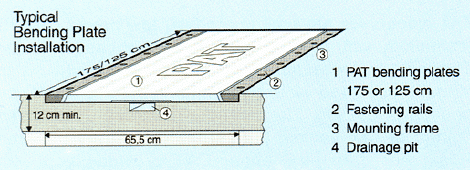

- Statistical traffic load recording
- Overloaded vehicle detection and sorting
- Secure area freight management
The bending plate is made of a high-strength steel plate. Two slots are milled on the bottom side. There are seven-wire strain guages installed in these slotes, along with some supplementary temperature compensation resistors. The strain guages and supplementary resistors are wired to form a wheatstone bridge.
The entre bending plate is covered with hot vulcanized neoprene rubber. Along the two long edges, there is additional rubber on the lower edge. This is used as the load bearing surface.
The bending plate operates by measuring the strain in the steel plate as it bends. The amount of bending is slight, about 2.3mm for 10 tons.
The strain in the steel plate concentrates at the two milled slots. The strain guages are bonded to the steel plate in these slots. Each strain guage changes its electrical resistivity as the strain increases. Therefore, the electrical resistance of the bending plate indicates the applied load.
IRD is committed to providing superior customer service, merging the best qualities of IRD and PAT Traffic under a single united company.
|
Technical Data: |
|
|
Physical |
|
|
Length |
1750mm (69.9") |
|
Height |
23mm (0.91") |
|
Width |
508mm (20.0") |
|
Weight |
114 kgs (265 lbs.) |
|
|
|
|
Environmental |
|
|
Temperature: |
|
|
Storage |
-40 to 80° C (-40 to 176° F) |
|
Operation, uncompensated |
-40 to 80° C (-40 to 176° F) |
|
Operation, compensated |
-10 to 50° C (14 to 122° F) |
|
Humidity |
10% to 100% |
|
Water Submersion |
300 hours maximum |
|
|
|
|
Operation: |
|
|
Nominal Load |
10 Tons (22,000 lbs.) |
|
Capacity (evenly distributed) |
30 Tons (66,000 lbs.) |
|
Temperature Drift: |
|
|
Sensitivity |
+/- 0.01° C +-0.02%/°F |
|
Zero Point |
+/-0.2%/°C +/-0.36%/°F |
|
Linearity |
+/-0.7% |
|
Transverse Sensitivity |
+/-1.5% |
|
Sensitivity |
0.8 mV/V Typical |
|
Zero Point, 10 Vdc Excitation, New Weightpad |
+/-10 mV |
|
Natural Frequency |
215 Hz |
|
|
|
|
Electrical Characteristics: |
|
|
Input resistance |
975 ½ |
|
Outout resistance |
840 ½ |
|
Insulation resistance |
> 100M½ |
|
Supply voltage |
9 to 24 Vdc |
|
Maximum voltage when measuring insulation resistance |
100 Vdc |